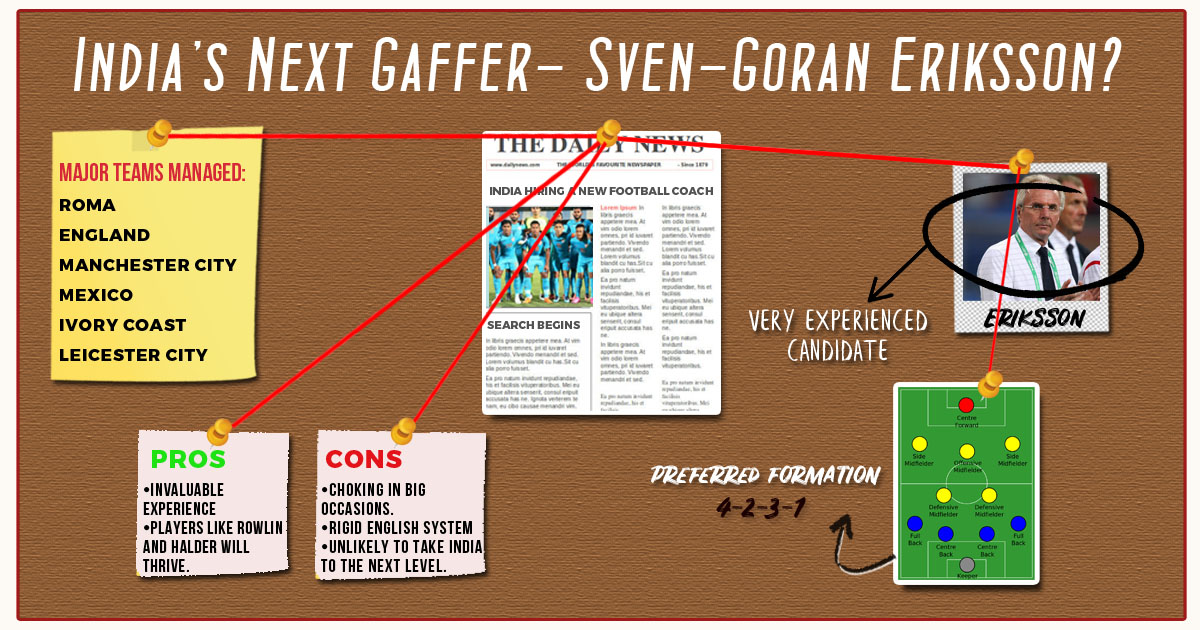India’s Next Gaffer | Under the scanner – Sven-Goran Eriksson
With the All India Football Federation (AIFF) on the hunt to replace Stephen Constantine for the position of the coach for the national football team, we look at how the few shortlisted candidates could fare at the job with their preferred tactics and past history starting with Sven-Goran Eriksson.

Claim to fame
Statistically speaking, Eriksson has been a member of a unique club by becoming the first manager to win league-and-cup doubles in three countries during his first 23 years as a manager, where he won eighteen trophies between 1979 and 2000. However, it was his management of England that had brought under the limelight.
Under his management, England had a historic 5-1 win over Germany on 2002 World Cup qualification, before they defeated Argentina and Denmark in the finals. Although England lost to Brazil in the round of 16, Eriksson had left a mark already and took England to the quarter-finals in Euro 2004 again. Though England didn’t do significantly well in 2006 World Cup either with Eriksson eventually leaving his post, he had improved England’s rating from seventeenth in January 2001 to fifth in July 2006 and reaching fourth during the 2006 World Cup.
In this period, Eriksson had overseen 67 games, winning 40, drawing 17, and losing only 10 matches. Following this, Eriksson had managed Mexico, Ivory Coast, and the Philippines at the international level but never got the same amount of success as he did with the Three Lions.
Preferred Tactics
With his most preferred setup being the 4-2-3-1, the Swedish manager’s stretch at most has been resorting to the conventional 4-4-2 and a 4-3-3 defending, which was quite evident with England and Mexico. Having managed as many as seventeen clubs, going with the safe four-man defence with a three-man midfield has always been expected of him. To top that, his Anglo-Saxon influences, which he had had since his playing days had led to the man being criticized heavily by the fans for lacking ideas.
Almost always preferring a rigid 4-4-2 setup, Eriksson has always emphasized on work rate and demanding his players to press opponents when not in possession of the ball. Despite being known for his European nuances in tactics, Eriksson was always drawn to this setup that was practised by Bobby Houghton and Roy Hodgson before being promoted by Tord Grip at Swedish side KB Karlskoga FF, where he played.
How can his ideas fit India
As far as his specialized tactics are concerned, the biggest concern with a 4-2-3-1 set-up super-imposed on an Indian side would mean the absence of a playmaker. The biggest criticism Eriksson had faced at the dusk of his England career was the lack of tactical astuteness from time to time. Hence, when a 0-0 draw wouldn’t be sufficient for the Blues at a particular game someday, Eriksson’s team would look as clueless as the guy that keeps pointing the TV remote at a microwave.
One look at the next generation of players making their way into the India squad and it is crystal clear that India could be a counter-attacking missile in years to come. In the likes of Michael Soosairaj, Udanta Sing, Sahal Abdul Samad, Ashique Kuruniyan, Jobby Justin, Brandon Fernandez, Farukh Choudhary, Jackichand Singh, Lallianzuala Chhangte, and many more, the Blues could be a side that could finish most Asian teams with pace when they hit their peak, and a 4-4-2, or better yet a 4-3-3 defensive formation could suit them ideally.
In the likes of Lenny Rodriguez, Rowlin Borges, and Pranoy Halder, India have defensive stability in their core, which would allow executing the zonal marking in a three-man midfield easier. This eliminates the need of a specialist playmaker as the side could hit on the counter repeatedly expecting a break. Hence, someone like Eriksson, who has a wealth of experience of working well with a crop of unknown talents, could be a welcome appointment for the Indian football team.
Verdict
While the future is known to all, football, like history, is known to repeat itself. And going by that, Eriksson could be a mixed bag of bunnies and bombs for Indian football. Even in his most glorious days, the Swedish was often called out for his tendency to fall short on the biggest of occasions, just like the Blues’ recent misadventures at the AFC Asia Cup where they were eliminated by an added-time winner against Bahrain, where a draw could have seen them historically qualifying for the playoffs.
Eriksson has seen his share of choking as well. Be it the dramatic late meltdown while managing Roma in the 1985-86 season, when after winning 3-0 against Juventus and almost pocketing the Scudetto, Eriksson’s side had lost 3-2 to Lecce to throw the title away, or losing to AC Milan 1-0 in the 1990 European Cup final, or more recently during his England stint, the Three Lions losing out on three occasions in the quarter-finals of major tournaments, the 71-year-old has had his share of nightmares as well.
While his experience would be invaluable to put it mildly, Eriksson, with his rigid English playing style, would not be very different from Stephen Constantine. To further compound that, the less number of international matches that the national team plays on a yearly basis has been embarrassing and is unlikely to help the manager’s cause anyway. Hence, barring a few eye-catching wins over higher ranked oppositions and at most improve India’s ranking, Eriksson isn’t much likely to take India to the next level in major tournaments.

Comments
Sign up or log in to your account to leave comments and reactions
0 Comments